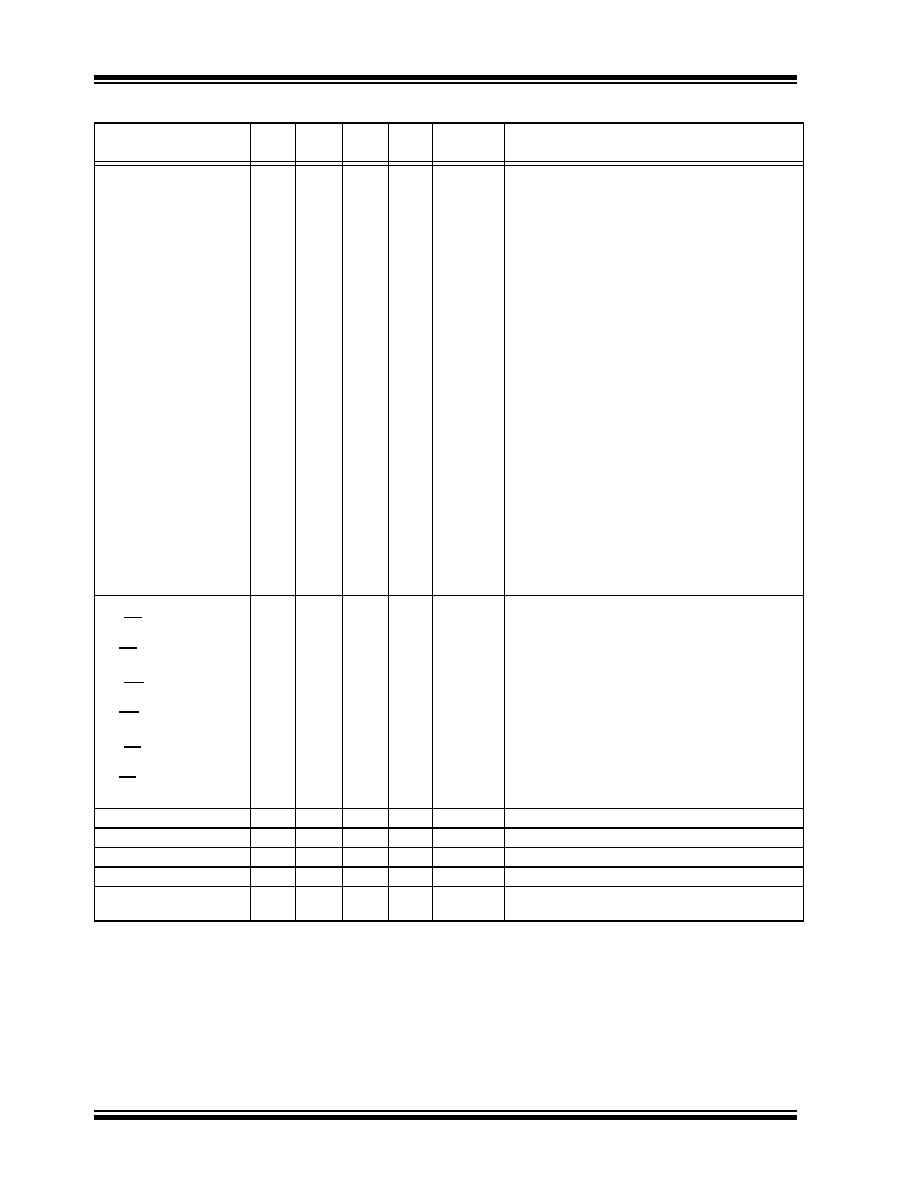- 您现在的位置:买卖IC网 > Sheet目录3841 > PIC16F737-I/SP (Microchip Technology)IC PIC MCU FLASH 4KX14 28DIP

PIC16F7X7
DS30498C-page 14
2004 Microchip Technology Inc.
PORTD is a bidirectional I/O port or Parallel Slave Port
when interfacing to a microprocessor bus.
RD0/PSP0
RD0
PSP0
19
38
I/O
ST/TTL(3)
Digital I/O.
Parallel Slave Port data.
RD1/PSP1
RD1
PSP1
20
39
I/O
ST/TTL(3)
Digital I/O.
Parallel Slave Port data.
RD2/PSP2
RD2
PSP2
21
40
I/O
ST/TTL(3)
Digital I/O.
Parallel Slave Port data.
RD3/PSP3
RD3
PSP3
22
41
I/O
ST/TTL(3)
Digital I/O.
Parallel Slave Port data.
RD4/PSP4
RD4
PSP4
27
2
I/O
ST/TTL(3)
Digital I/O.
Parallel Slave Port data.
RD5/PSP5
RD5
PSP5
28
3
I/O
ST/TTL(3)
Digital I/O.
Parallel Slave Port data.
RD6/PSP6
RD6
PSP6
29
4
I/O
ST/TTL(3)
Digital I/O.
Parallel Slave Port data.
RD7/PSP7
RD7
PSP7
30
5
I/O
ST/TTL(3)
Digital I/O.
Parallel Slave Port data.
PORTE is a bidirectional I/O port.
RE0/RD/AN5
RE0
RD
AN5
825
25
I/O
I
ST/TTL(3)
Digital I/O.
Read control for Parallel Slave Port.
Analog input 5.
RE1/WR/AN6
RE1
WR
AN6
926
26
I/O
I
ST/TTL(3)
Digital I/O.
Write control for Parallel Slave Port.
Analog input 6.
RE2/CS/AN7
RE2
CS
AN7
10
27
I/O
I
ST/TTL(3)
Digital I/O.
Chip select control for Parallel Slave Port.
Analog input 7.
VSS
—
31
—
P
—
Analog ground reference.
VSS
12, 31
6, 30
6, 29
P
—
Ground reference for logic and I/O pins.
VDD
—
8
—
P
—
Analog positive supply.
VDD
11, 32
7, 28
P
—
Positive supply for logic and I/O pins.
NC
—
13, 29
12, 13,
33, 34
—
These pins are not internally connected. These pins
should be left unconnected.
TABLE 1-3:
PIC16F747 AND PIC16F777 PINOUT DESCRIPTION (CONTINUED)
Pin Name
PDIP
Pin #
QFN
Pin #
TQFP
Pin #
I/O/P
Type
Buffer
Type
Description
Legend:
I = input
O = output
I/O = input/output
P = power
— = Not used
TTL = TTL input
ST = Schmitt Trigger input
Note
1:
This buffer is a Schmitt Trigger input when configured as an external interrupt.
2:
This buffer is a Schmitt Trigger input when used in Serial Programming mode.
3:
This buffer is a Schmitt Trigger input when configured as a general purpose I/O and a TTL input when used in the Parallel
Slave Port mode (for interfacing to a microprocessor bus).
4:
This buffer is a Schmitt Trigger input when configured in RC Oscillator mode and a CMOS input otherwise.
5:
Pin location of CCP2 is determined by the CCPMX bit in Configuration Word Register 1.
发布紧急采购,3分钟左右您将得到回复。
相关PDF资料
PIC18F86K22-I/PTRSL
MCU PIC 64K FLASH XLP 80TQFP
PIC16C63A-04I/SP
IC MCU OTP 4KX14 PWM 28DIP
PIC16C63A-04I/SO
IC MCU OTP 4KX14 PWM 28SOIC
52559-2270
CONN FFC 22POS .5MM VERT ZIF SMD
52559-1870
CONN FFC 18POS .5MM VERT ZIF SMD
DSPIC33EP64MC506-I/PT
IC DSC 16BIT 64KB FLASH 64TQFP
52745-1896
CONN FFC 18POS .5MM R/A ZIF SMD
PIC16LC622-04/P
IC MCU OTP 2KX14 COMP 18DIP
相关代理商/技术参数
PIC16F737-I/SP
制造商:Microchip Technology Inc 功能描述:IC 8BIT FLASH MCU 16F737 SDIL28
PIC16F737-I/SS
功能描述:8位微控制器 -MCU 7KB 368 RAM 25 I/O RoHS:否 制造商:Silicon Labs 核心:8051 处理器系列:C8051F39x 数据总线宽度:8 bit 最大时钟频率:50 MHz 程序存储器大小:16 KB 数据 RAM 大小:1 KB 片上 ADC:Yes 工作电源电压:1.8 V to 3.6 V 工作温度范围:- 40 C to + 105 C 封装 / 箱体:QFN-20 安装风格:SMD/SMT
PIC16F737T-I/ML
功能描述:8位微控制器 -MCU 7KB 368 RAM 25 I/O RoHS:否 制造商:Silicon Labs 核心:8051 处理器系列:C8051F39x 数据总线宽度:8 bit 最大时钟频率:50 MHz 程序存储器大小:16 KB 数据 RAM 大小:1 KB 片上 ADC:Yes 工作电源电压:1.8 V to 3.6 V 工作温度范围:- 40 C to + 105 C 封装 / 箱体:QFN-20 安装风格:SMD/SMT
PIC16F737T-I/SO
功能描述:8位微控制器 -MCU 7KB 368 RAM 25 I/O RoHS:否 制造商:Silicon Labs 核心:8051 处理器系列:C8051F39x 数据总线宽度:8 bit 最大时钟频率:50 MHz 程序存储器大小:16 KB 数据 RAM 大小:1 KB 片上 ADC:Yes 工作电源电压:1.8 V to 3.6 V 工作温度范围:- 40 C to + 105 C 封装 / 箱体:QFN-20 安装风格:SMD/SMT
PIC16F737T-I/SS
功能描述:8位微控制器 -MCU 7KB 368 RAM 25 I/O RoHS:否 制造商:Silicon Labs 核心:8051 处理器系列:C8051F39x 数据总线宽度:8 bit 最大时钟频率:50 MHz 程序存储器大小:16 KB 数据 RAM 大小:1 KB 片上 ADC:Yes 工作电源电压:1.8 V to 3.6 V 工作温度范围:- 40 C to + 105 C 封装 / 箱体:QFN-20 安装风格:SMD/SMT
PIC16F73-E/ML
功能描述:8位微控制器 -MCU 7 KB 368 RAM 25I/O RoHS:否 制造商:Silicon Labs 核心:8051 处理器系列:C8051F39x 数据总线宽度:8 bit 最大时钟频率:50 MHz 程序存储器大小:16 KB 数据 RAM 大小:1 KB 片上 ADC:Yes 工作电源电压:1.8 V to 3.6 V 工作温度范围:- 40 C to + 105 C 封装 / 箱体:QFN-20 安装风格:SMD/SMT
PIC16F73-E/SO
功能描述:8位微控制器 -MCU 7KB 192 RAM 22 I/O RoHS:否 制造商:Silicon Labs 核心:8051 处理器系列:C8051F39x 数据总线宽度:8 bit 最大时钟频率:50 MHz 程序存储器大小:16 KB 数据 RAM 大小:1 KB 片上 ADC:Yes 工作电源电压:1.8 V to 3.6 V 工作温度范围:- 40 C to + 105 C 封装 / 箱体:QFN-20 安装风格:SMD/SMT
PIC16F73-E/SP
功能描述:8位微控制器 -MCU 7KB 192 RAM 22 I/O RoHS:否 制造商:Silicon Labs 核心:8051 处理器系列:C8051F39x 数据总线宽度:8 bit 最大时钟频率:50 MHz 程序存储器大小:16 KB 数据 RAM 大小:1 KB 片上 ADC:Yes 工作电源电压:1.8 V to 3.6 V 工作温度范围:- 40 C to + 105 C 封装 / 箱体:QFN-20 安装风格:SMD/SMT